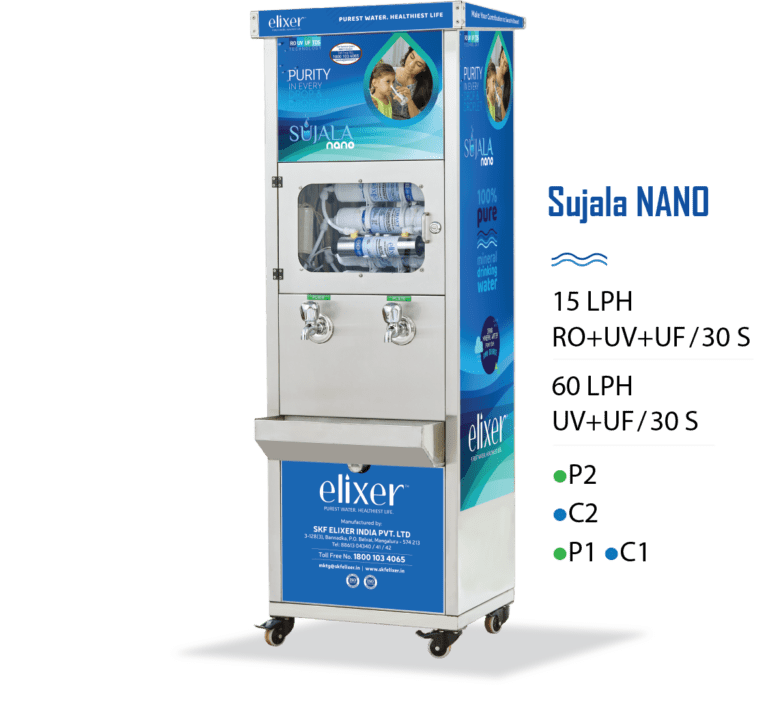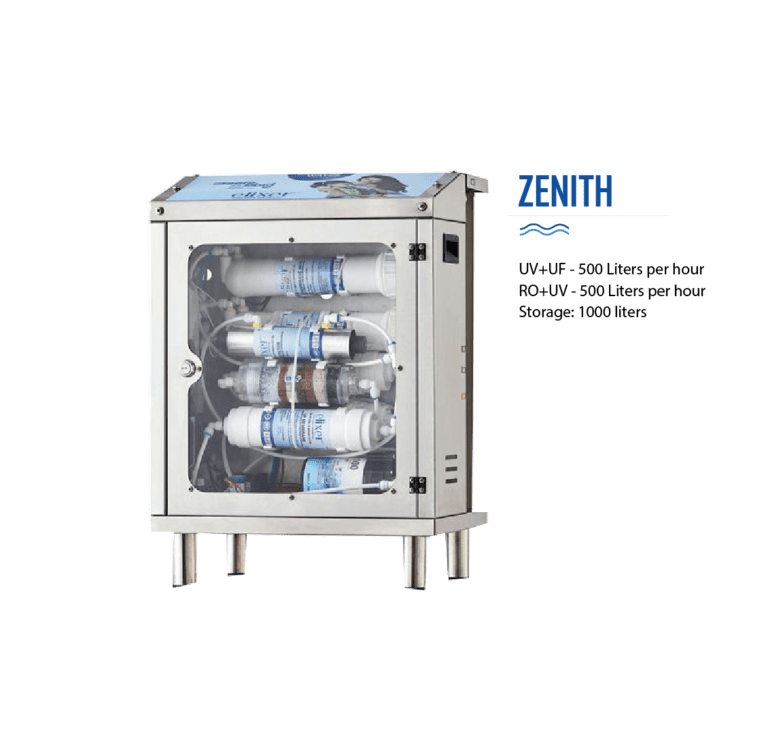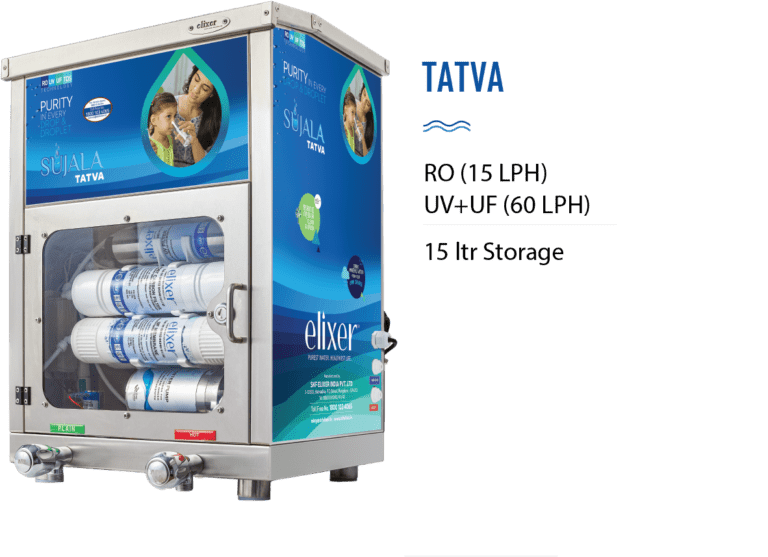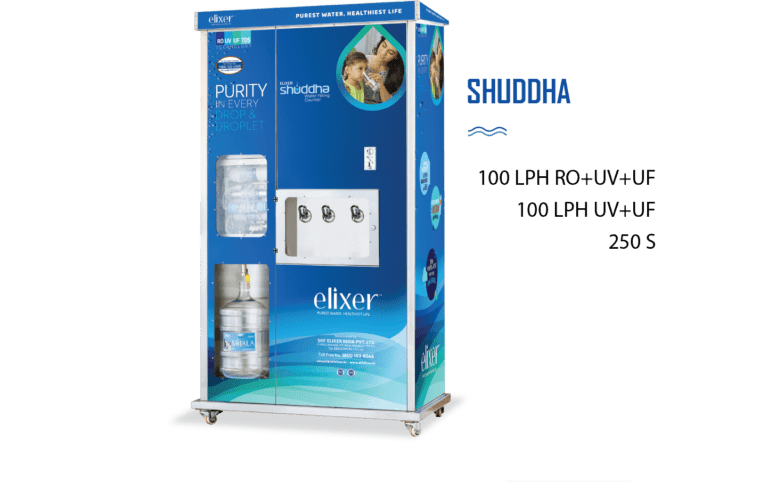Table of Contents
In India’s bustling cities and growing towns, access to clean drinking water remains a daily concern for millions. Municipal water supply, while widespread, often carries contaminants like bacteria, heavy metals, and sediments, making it unreliable for direct consumption. With over 70% of urban households relying on municipal water, the need for effective home water purification has never been more critical.
SKF Elixer addresses this challenge with its advanced water purifier for municipal water, designed to deliver safe, mineral-enriched water tailored to India’s unique water quality issues. Our smart water purifiers combine cutting-edge technology with user-friendly features, ensuring every household enjoys pure, healthy water.
This blog explores how smart water purifiers transform municipal water into safe drinking water, the technologies that make them ideal for Indian homes, and why SKF Elixer’s solutions stand out in the quest for the best water purifier for home use. From families in Delhi to apartment complexes in Chennai, our systems offer a reliable path to clean water.
The Challenge of Municipal Water in India
Municipal water in India, supplied through extensive networks of pipes, often faces quality issues due to aging infrastructure, contamination, and inconsistent treatment. Studies show that 60–70% of municipal water sources contain coliform bacteria, while high total dissolved solids (TDS) levels (300–1,000 mg/L) and heavy metals like lead or arsenic affect water safety in cities.
Consuming untreated tap water can lead to waterborne diseases, impacting over 30 million Indians annually. For a family of four consuming 20 litres of water daily, this translates to a health risk worth addressing, especially when safe alternatives cost as little as ₹20,000–₹30,000 upfront.
Smart water purifiers are designed to tackle these challenges, offering advanced filtration, real-time monitoring, and user-friendly features. Unlike traditional purifiers, SKF Elixer’s systems integrate smart technology, to ensure consistent water quality and ease of maintenance, making them ideal for municipal water purifiers in Indian homes.
How Smart Water Purifiers Work
Smart water purifiers employ a multi-stage purification process to transform municipal tap water into safe, mineral-enriched drinking water. Each stage targets specific contaminants, ensuring compliance with Bureau of Indian Standards (BIS) norms for potable water.
Here’s a look at the science behind these systems:
- Pre-Filtration
Municipal water often contains visible impurities like sand, rust, or sediment from old pipes. Pre-filters, with 5–10 micron pore sizes, remove 2–3 grams of solids per 1,000 litres.
- Carbon Filtration
Activated carbon filters eliminate organic compounds, chlorine, and odors, improving taste and clarity. For a typical urban household consuming 15–20 litres daily, this removes 90–95% of chemical contaminants, ensuring water is palatable and safe for cooking and drinking.
- Reverse Osmosis (RO) System
The RO stage removes dissolved salts, heavy metals, and fluoride, reducing TDS from 500–1,000 mg/L to 50–100 mg/L, meeting BIS standards. High-recovery RO systems, handling 500–2,000 litres per day, waste only 20–25% of water, saving 100–200 litres daily compared to conventional purifiers, a critical feature in water-scarce cities like Bengaluru.
- UV Purification
Ultraviolet (UV) purification ensures microbiological safety, delivering a 40 mJ/cm² dosage to eliminate 99.99% of bacteria and viruses. For a family using 20 litres daily, this guarantees zero microbial contamination, vital for preventing diseases like typhoid in areas with inconsistent municipal treatment.
- Water Purifier with Mineralizer
Post-RO, water can taste flat due to low mineral content. Mineralizer adds calcium (20–40 mg/L) and magnesium (10–20 mg/L), enhancing taste and health benefits. For a 1,000-litre-per-day system, this ensures consistent mineral levels, making water refreshing for households.
- Smart Features
Smart purifiers include sensors for real-time TDS and filter health monitoring, with mobile app notifications for maintenance alerts. For a 500-litre-per-day unit, this reduces downtime by 90%, saving ₹2,000–₹3,000 annually on repairs, making it a top choice among smart home appliances.
Smart Water Purifiers for Indian Homes
Smart water purifiers employ a multi-stage purification process to transform municipal tap water into safe, mineral-enriched drinking water. Each stage targets specific contaminants, ensuring compliance with Bureau of Indian Standards (BIS) norms for potable water.
Here’s a look at the science behind these systems:
- Pre-Filtration
Municipal water often contains visible impurities like sand, rust, or sediment from old pipes. Pre-filters, with 5–10 micron pore sizes, remove 2–3 grams of solids per 1,000 litres.
- Carbon Filtration
Activated carbon filters eliminate organic compounds, chlorine, and odors, improving taste and clarity. For a typical urban household consuming 15–20 litres daily, this removes 90–95% of chemical contaminants, ensuring water is palatable and safe for cooking and drinking.
- Reverse Osmosis (RO) System
The RO stage removes dissolved salts, heavy metals, and fluoride, reducing TDS from 500–1,000 mg/L to 50–100 mg/L, meeting BIS standards. High-recovery RO systems, handling 500–2,000 litres per day, waste only 20–25% of water, saving 100–200 litres daily compared to conventional purifiers, a critical feature in water-scarce cities like Bengaluru.
- UV Purification
Ultraviolet (UV) purification ensures microbiological safety, delivering a 40 mJ/cm² dosage to eliminate 99.99% of bacteria and viruses. For a family using 20 litres daily, this guarantees zero microbial contamination, vital for preventing diseases like typhoid in areas with inconsistent municipal treatment.
- Water Purifier with Mineralizer
Post-RO, water can taste flat due to low mineral content. Mineralizer adds calcium (20–40 mg/L) and magnesium (10–20 mg/L), enhancing taste and health benefits. For a 1,000-litre-per-day system, this ensures consistent mineral levels, making water refreshing for households.
- Smart Features
Smart purifiers include sensors for real-time TDS and filter health monitoring, with mobile app notifications for maintenance alerts. For a 500-litre-per-day unit, this reduces downtime by 90%, saving ₹2,000–₹3,000 annually on repairs, making it a top choice among smart home appliances.
Community Solutions
Residential societies and schools, requiring 500–1,000 litres daily, can opt for community purifiers, starting at ₹1 lakh. These systems address high TDS (up to 2,000 mg/L) in cities, delivering BIS-compliant water and reducing water procurement costs by ₹50,000–₹1 lakh annually.
Benefits of Using Smart Water Purifiers at Home
Smart water purifiers offer compelling advantages:
- Health and Safety: Removes 99.9% of contaminants, ensuring safe water and reducing health risks from waterborne diseases, saving families ₹5,000–₹10,000 annually on medical expenses.
- Cost Savings: High-recovery RO and energy-efficient designs save ₹2,000–₹5,000 yearly on electricity and water bills for a 500-litre-per-day unit.
- Convenience: Mobile app notifications for filter changes and water quality reduce maintenance hassle, saving 10–15 hours annually.
Water Purifier Maintenance Made Easy
Maintenance is critical for consistent performance. Smart purifiers can feature sensors that alert users via mobile apps when filters or membranes need replacement, typically every 6–12 months. Annual Maintenance Contracts (AMCs) include servicing and parts, ensuring 98% uptime and savings of ₹1,000–₹2,000 annually on repairs. For households, this means hassle-free access to clean water year-round.
Why Choose SKF Elixer?
SKF Elixer brings expertise in water purification, delivering BIS-certified purifiers designed for Indian municipal water challenges. Our systems are built for durability in high-TDS regions like Rajasthan or Tamil Nadu, with options and support. From compact units for small homes to high-capacity systems for communities, we ensure clean, mineral-enriched water for all.
Conclusion
Smart water purifiers are transforming how Indian households access clean drinking water, making municipal supply safe and reliable. SKF Elixer’s advanced systems, with RO, UV, and UF features, deliver health, convenience, and sustainability. By choosing our purifiers, you’re investing in a healthier future for your family and community.
Ready to bring smart water purification to your home? Contact SKF Elixer to explore the best water purification solutions and ensure pure water every day.
FAQs
- How do smart water purifiers improve municipal water quality?
Smart purifiers use pre-filtration, carbon filtration, RO, UV purification, and mineralizers to remove 99.9% of contaminants, reducing TDS from 500–1,000 mg/L to 50–100 mg/L and eliminating bacteria, ensuring BIS-compliant water for homes using 10–100 litres daily. - What makes SKF Elixer’s purifiers the best water purifier for Indian municipal supply?
Our purifiers combine high-recovery RO, UV, and UF disinfection. This ensures consistent quality, saves water, and reduces operational costs by ₹2,000–₹5,000 annually. - How does the water purifier with mineralizer benefit households?
The mineralizer adds calcium (20–40 mg/L) and magnesium (10–20 mg/L), enhancing taste and health benefits. For a family consuming 20 litres daily, this ensures refreshing, nutrient-rich water, meeting consumer preferences in urban areas. - What is involved in water purifier maintenance for water purification systems?
Maintenance includes filter and membrane replacement every 6–12 months, with IoT sensors alerting users via mobile apps. AMCs, starting at ₹2,000 per year, cover servicing and parts, ensuring 98% uptime and savings of ₹1,000–₹2,000 annually. - How do I select a water purifier for city tap water in India?
Choose a purifier based on TDS levels (500–2,000 mg/L requires RO), daily usage (10–100 litres for homes), and smart features like IoT monitoring. Smart systems offer tailored solutions for cities like Mumbai or Chennai, ensuring safe, mineral-enriched water.
Good reads are meant to be shared









